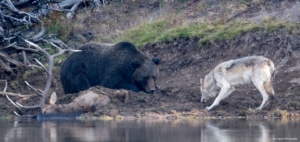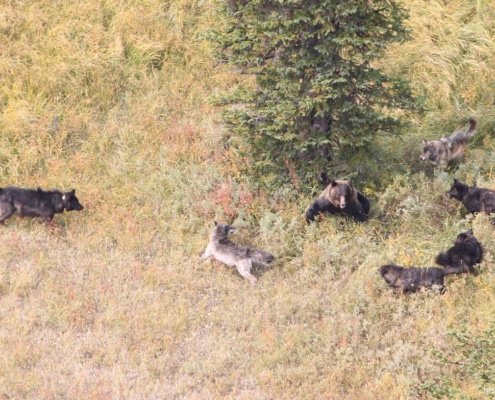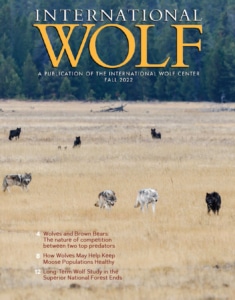Wolves and Brown Bears
The nature of competition between two top predators
By Aimee Tallian
It was the last thing we expected, or hoped, to see that day. My hiking partner and I were deep in Yellowstone National Park’s backcountry on a mission to retrieve a dropped wolf GPS collar. Hiking off-trail on a snowy October day, we stumbled upon a fresh elk carcass. A mother grizzly and her cub stood on top of it, with several members of Mollie’s wolf pack milling about nearby. We didn’t stick around to watch the interaction play out—indeed, we hightailed it out of there as fast and as safely as our feet could carry us. But after countless hours of observing such interactions from safer locations, we knew exactly what was happening. These animals were participating in a tug of war for access to the life-sustaining meat this carcass would provide. These interactions are commonplace in Yellowstone and anywhere wolves’ territories overlap with those of brown bears or grizzly bears. Yet, we still know surprisingly little about how this competition shapes the lives of both predators or how it affects the ecosystems they occupy.

Gray wolves and brown bears historically coexisted across most of their range in the Northern Hemisphere, and although both species suffered declines over the last several centuries, their remaining populations still commonly overlap today. Wolves are primarily meat eaters that are both savvy predators and underappreciated scavengers. They are commonly considered apex predators, meaning they sit atop their food chain, and their quest for food ripples throughout their ecosystem.
Conversely, brown bears are omnivores that target seasonally available foods ranging from berries and insects to moose and musk-oxen. As intermittent carnivores, they mainly access meat by preying on newborn ungulates and opportunistically scavenging on larger ungulate carcasses. Bears also play an important role in their ecosystem. For example, they facilitate seed dispersal via their droppings and, as ‘part-time’ apex predators, they impact ungulate populations by preying heavily on newborn calves.
Although wolves and bears approach the food world very differently, they are serious competitors. They indirectly ‘share’ a common prey resource—newborn calves—and directly compete over access to ungulate carcasses, wolf-killed or otherwise. It is well known that brown bears lumber into wolf kill-sites and steal their hard-earned food. This observation led to the common assumption that, where wolves and bears overlapped, stolen food would cause wolves to kill more often. This pattern has been observed with mountain lions and Eurasian lynx, for example. When bears move into cat kill-sites, the cats generally leave, forfeit their meal and start a new hunt sooner than they otherwise would have. Over time, this results in a higher kill rate for cats that deal with bears on a regular basis. However, recent evidence suggests that wolves kill less often where they compete with bears. Although this finding was initially counterintuitive, new research sheds light on why this occurs.
We can begin to explain this by reviewing some ecological theory. In general, two types of competition take place between top predators. The first is interference competition, which commonly involves direct interactions resulting in resource exclusion. Think: a child’s older sibling comes over and takes the Halloween candy right out of the child’s hands while they are eating it.
The other, exploitation competition, mostly involves indirect interactions that result in fewer food resources on the landscape, i.e., resource limitation. Think: the older sibling comes into the room while the child is gone and steals half of their Halloween candy.

A pack of gray wolves are pictured in a conflict with a grizzly bear in Yellowstone National Park. The two species often are in a tug of war over carcasses within the park.
Imagine how this might play out for wolves and bears. Wolves move throughout a landscape in search of vulnerable prey. Once found, the wolves must dedicate time and energy to attack, capture, consume and digest it. Formally known as “search time” and “handling time,” these two components make up the core of a wolf’s predatory sequence—i.e., what happens between one kill and the next. Generally, if search time or handling time increases or decreases, a predator’s kill rate responds in the opposite direction. In our previous example, bears caused cats to decrease prey-handling time; after the sibling stole their candy, they gave up and left to look for candy elsewhere. This resulted in an increased overall kill rate.
On the flip side, if either handling time or search time increases, kill rate will likely decrease. In the context of wolves and bears, handling time might increase if the bear’s presence caused wolves to spend additional time either defending their kill or waiting for access to the stolen carcass rather than abandoning it; wolves stick around and fight for, or try to sneakily gain access to, what was once their candy. Search time, on the other hand, might increase if bears reduce the supply of shared prey on the landscape, simply because they leave fewer prey there to find.
In other words, increased handling time would suggest that interference competition is occurring, while increased search time would suggest exploitation competition is occurring. Indeed, evidence from Yellowstone National Park and Scandinavia, two systems that support long-term research projects on both wolves and bears, suggests both interference and exploitation take place. Which form of competition is occurring, however, depends on the season and the context of the system.
During the bear den-emergence period in Scandinavia, when wolves hunt last year’s grown moose calves and bears scavenge for meat, interference competition is the primary mechanism driving decreased wolf kill-rates. Handling time increases in the presence of bears, but search time stays the same. This is presumably because bears move in on wolf kills, and wolves have to spend extra time defending or trying to access the kill. In Scandinavia, evidence suggests that wolves are spending more time moving back-and-forth between their kill sites, probably to avoid direct interactions with bears.
After the moose birthing pulse begins, however, the type of competition switches. During this period in Scandinavia, both bears and wolves commonly kill small, newborn moose, and exploitation competition starts to alter wolf predation patterns. Search time increases but handling time does not, presumably because bears are killing newborn moose before the wolves can, which leaves fewer on the landscape for wolves to find.
In Yellowstone, unlike Scandinavia, interference competition does affect wolf predation patterns during the ungulate birthing period. Key differences between the two study systems point to why the type of competition varies.
Wolves in Scandinavia primarily hunt moose, and commonly hunt larger prey, including last year’s calves, yearling and adult moose, but switch to newborn moose in the birthing season. During that time, small calves make up 85% to 90% of their diet. Yellowstone is a bit different; while elk are the main prey for wolves, their diet is much more varied. Wolves in Yellowstone select for newborn elk during early summer (the calves comprise about 65% of their kills), but they continue to prey on other species and older elk. Thus, there is probably more room for interference competition during this period in Yellowstone than in Scandinavia. Newborn calves are consumed quickly by both predators, but larger kills provide both time and incentive—in the form of remaining meat—for direct, competitive interactions. Although untested, it is likely that exploitation competition occurs in Yellowstone, as well, where bears, too, prey heavily on newborn calves.
Unlike interactions between bears and cats, the metaphorical “wolf” kid sticks around after the sibling steals their candy, either fighting for it or trying to sneak access to it. This might happen for several reasons. First, it takes a great deal of time and energy for wolves to take down prey, and the process is fraught with risk. Wolves regularly risk injury or even death when hunting large, dangerous prey like elk and moose. Risk is especially high during summer, when prey animals are healthy and fit. So the energy cost of fighting for their kill, or lingering and trying to gain access to it, might make it worthwhile—especially if the next kill they make is just as likely to be stolen as the last one.
Second, these two species might be more evenly matched (bears are big, but wolves are numerous). While bears are often able to dominate carcasses, the outcome of interactions between wolves and bears varies based on who the players are (e.g., the age, sex, and size of animals in each species) and the number of individuals involved. Interactions at kill sites between more closely matched competitors are likely prolonged, rather than cut-short, because the potential for meat reward is greater. Thus, the predator must search for and kill their next prey later than they otherwise would have, resulting in a decreased overall kill rate.
Yet, it is still unknown to what extent competition between wolves and bears negatively or positively affect each other’s population numbers, and how this relationship will shift as the climate changes. For example, will competition become more intense in Yellowstone if key bear foods, such a whitebark pine, decline? The answer remains unclear.
Interactions between top predators, including wolves and brown bears, are likely an important structuring force across the globe. Competition among predators can stabilize ecosystem dynamics, and complete assemblages of large carnivores and scavenger communities have been linked to ecological resilience. Understanding the nature of competition between top predators is therefore important for both our fundamental understanding of ecology, as well as for determining the impacts of their loss or recovery. And there is still much we do not know.

It takes time and energy for wolves to take down prey, and the process is fraught with risk. So the energy cost of fighting for their kill, or lingering and trying to gain access to it, might make it worthwhile—especially if the next kill they make is just as likely to be stolen as the last one.
 This article was originally published in the Fall 2022 edition of International Wolf magazine, which is published quarterly by the International Wolf Center. The magazine is mailed exclusively to members of the Center.
This article was originally published in the Fall 2022 edition of International Wolf magazine, which is published quarterly by the International Wolf Center. The magazine is mailed exclusively to members of the Center.
To learn more about membership, click here.
Dr. Aimee Tallian
At the age of 18, the author went to work in Yellowstone National Park, where she managed and studied wolves, bears and bison for 12 years before earning a Ph.D. in wildlife ecology at Utah State University. Her dissertation investigations revealed how wolves interact with other large animals like bison and grizzly bears. Now a researcher at the Norwegian Institute for Nature Research, Dr. Tallian continues to study wolves and grizzly bears to understand how competition between these two apex predators affects their ecosystem.

The International Wolf Center uses science-based education to teach and inspire the world about wolves, their ecology, and the wolf-human relationship.

